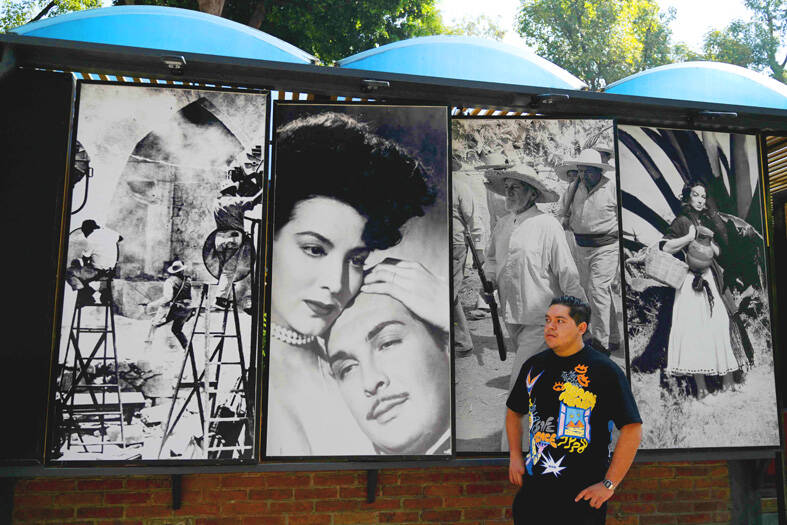Despite his international success, including a new adaptation of the classic puppet tale Pinocchio, Oscar-winning Mexican director Guillermo del Toro said he fears that his country’s cinema industry is facing “systematic destruction.”
Del Toro’s animated version of Pinocchio, in which an elderly woodcarver and his living puppet find themselves in 1930s fascist Italy, was the most watched film on streaming platform Netflix in the week of Dec. 12.
Its debut on Dec. 9 came a week before the release of Bardo, an autobiographical tale of a journalist-filmmaker returning home after years in Los Angeles, by fellow Mexican Alejandro Gonzalez Inarritu.

Photo: AFP
Mexican actors have also enjoyed recent success in Hollywood, including Tenoch Huerta, the rising star of the sequel to Black Panther, the first major black superhero movie.
Del Toro, Inarritu and Alfonso Cuaron represent a golden generation of Mexican filmmakers who have won the best director trophy at the Oscars five times since 2013.
Del Toro’s fantasy romance The Shape of Water earned best picture and best director at the 2018 Oscars.

Photo: AFP
The following year Cuaron scooped three golden statuettes for Roma — an intimate black-and-white movie about a family in turmoil in 1970s Mexico City.
However, in stark contrast to the international acclaim for the trio, dubbed “The Three Amigos,” del Toro has said that the country’s film industry is facing “unprecedented” challenges.
“The systematic destruction of Mexican cinema and its institutions — which took decades to build — has been brutal,” he wrote on Twitter last month.
Del Toro highlighted an announcement by the Mexican Academy of Cinematographic Arts and Sciences that next year’s Ariel Awards — the country’s equivalent of the Oscars — were postponed until further notice due to a “serious financial crisis.”
The organization said it regretted that “the support of public resources has decreased considerably in recent years.”
“The state, which was the motor and support of the academy for a long time, has renounced its responsibility as the main promoter and disseminator of culture in general and of cinema in particular,” it added.
Del Toro even offered to pay for the Ariel statuettes out of his own pocket.
“He’s a generous colleague, an artist who is always aware of what is happening not only with Mexican cinematography, but with the arts in general in the country,” academy president Leticia Huijara said.
However, she said she would prefer an agreement with the state.
In the meantime, the Ariels have been postponed, she said.
Maria Novaro, the general manager of the Mexican Film Institute (IMCINE), a government agency, said the warnings are exaggerated.
“Del Toro says that there is no more Mexican cinema in the year when there have never been so many productions,” she said, hailing a “record” 256 films last year.
“And 56 percent received support from public money. IMCINE devotes 900 million pesos [US$46.53 million] a year to financing Mexican cinema,” she said.
“It’s good that Netflix produces a lot of content in Mexico, but it does not replace what IMCINE does,” she added.
Mexican cinema enjoyed a golden age between the 1930s and 1950s, featuring movie stars such as Dolores del Rio and Pedro Armendariz.
However, the industry went through a quiet period before enjoying a revival, helped in the past few years by the success of “The Three Amigos.”
Mexican cinema has become decentralized and diversified, Novaro said, mirroring Mexican President Andres Manuel Lopez Obrador’s priorities to help impoverished and indigenous Mexicans.
Since 2019, there has been a program to encourage indigenous and Afro-descendant cinema, with 56 such films in production, Novaro said.
“Films are starting to come out that tell about migration from the perspective of indigenous migrants themselves,” she added.

With an approval rating of just two percent, Peruvian President Dina Boluarte might be the world’s most unpopular leader, according to pollsters. Protests greeted her rise to power 29 months ago, and have marked her entire term — joined by assorted scandals, investigations, controversies and a surge in gang violence. The 63-year-old is the target of a dozen probes, including for her alleged failure to declare gifts of luxury jewels and watches, a scandal inevitably dubbed “Rolexgate.” She is also under the microscope for a two-week undeclared absence for nose surgery — which she insists was medical, not cosmetic — and is

CAUTIOUS RECOVERY: While the manufacturing sector returned to growth amid the US-China trade truce, firms remain wary as uncertainty clouds the outlook, the CIER said The local manufacturing sector returned to expansion last month, as the official purchasing managers’ index (PMI) rose 2.1 points to 51.0, driven by a temporary easing in US-China trade tensions, the Chung-Hua Institution for Economic Research (CIER, 中華經濟研究院) said yesterday. The PMI gauges the health of the manufacturing industry, with readings above 50 indicating expansion and those below 50 signaling contraction. “Firms are not as pessimistic as they were in April, but they remain far from optimistic,” CIER president Lien Hsien-ming (連賢明) said at a news conference. The full impact of US tariff decisions is unlikely to become clear until later this month

GROWING CONCERN: Some senior Trump administration officials opposed the UAE expansion over fears that another TSMC project could jeopardize its US investment Taiwan Semiconductor Manufacturing Co (TSMC, 台積電) is evaluating building an advanced production facility in the United Arab Emirates (UAE) and has discussed the possibility with officials in US President Donald Trump’s administration, people familiar with the matter said, in a potentially major bet on the Middle East that would only come to fruition with Washington’s approval. The company has had multiple meetings in the past few months with US Special Envoy to the Middle East Steve Witkoff and officials from MGX, an influential investment vehicle overseen by the UAE president’s brother, the people said. The conversations are a continuation of talks that

CHIP DUTIES: TSMC said it voiced its concerns to Washington about tariffs, telling the US commerce department that it wants ‘fair treatment’ to protect its competitiveness Taiwan Semiconductor Manufacturing Co (TSMC, 台積電) yesterday reiterated robust business prospects for this year as strong artificial intelligence (AI) chip demand from Nvidia Corp and other customers would absorb the impacts of US tariffs. “The impact of tariffs would be indirect, as the custom tax is the importers’ responsibility, not the exporters,” TSMC chairman and chief executive officer C.C. Wei (魏哲家) said at the chipmaker’s annual shareholders’ meeting in Hsinchu City. TSMC’s business could be affected if people become reluctant to buy electronics due to inflated prices, Wei said. In addition, the chipmaker has voiced its concern to the US Department of Commerce